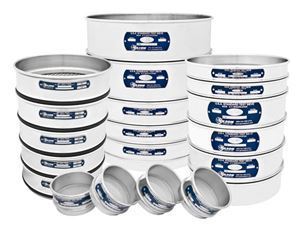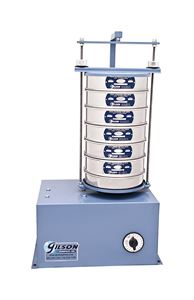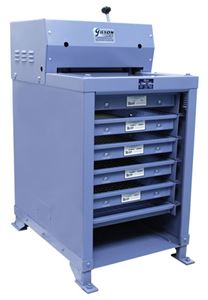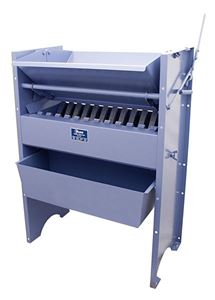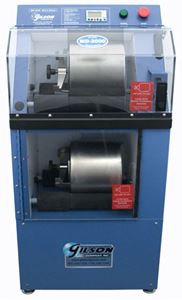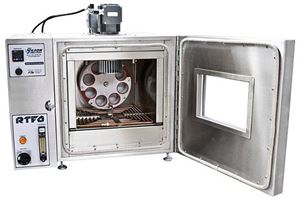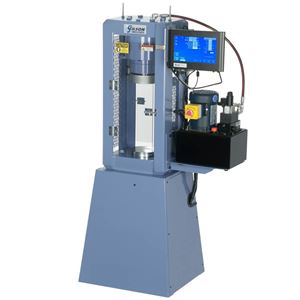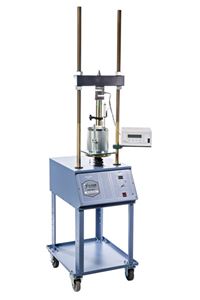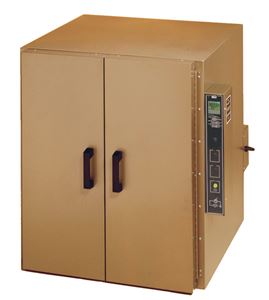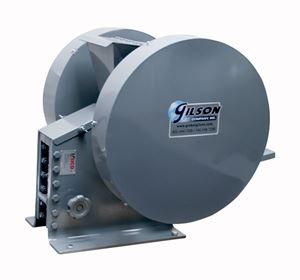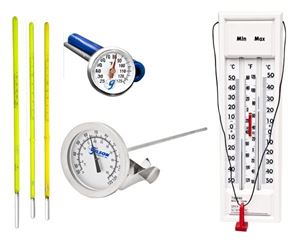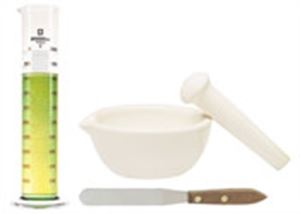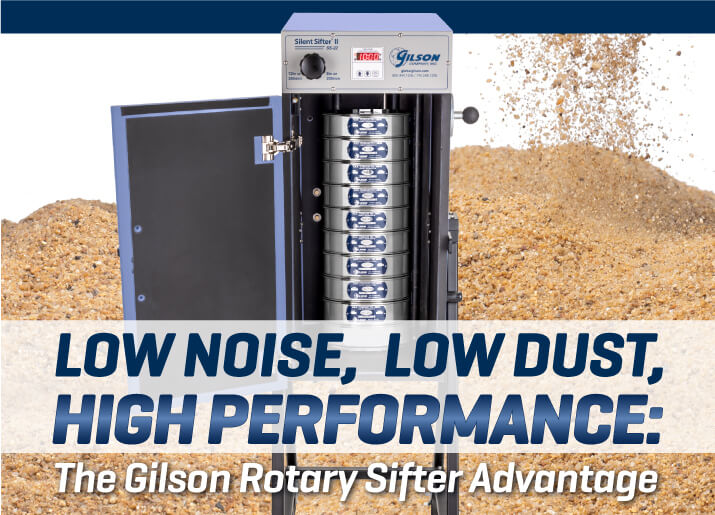
Rotary Lab Sifters:
For decades, the rotary sifter has been a recognizable fixture in construction material testing labs. Dubbed the "Mary Ann" after a popular calypso song with lyrics, "…down by the seaside sifting sand…", this sieve shaker quickly became popular for particle size testing of aggregates and soils, along with other granular materials.
Efficiency and ease of use have made the rotary lab sifter a perennial favorite for sieving dry, easily separated granular materials like mineral aggregates for sieve sizes from 1in to No. 635 (25.4mm to 20µm). Some state DOT agencies prefer this type of sieve shaker over other mechanical shakers.
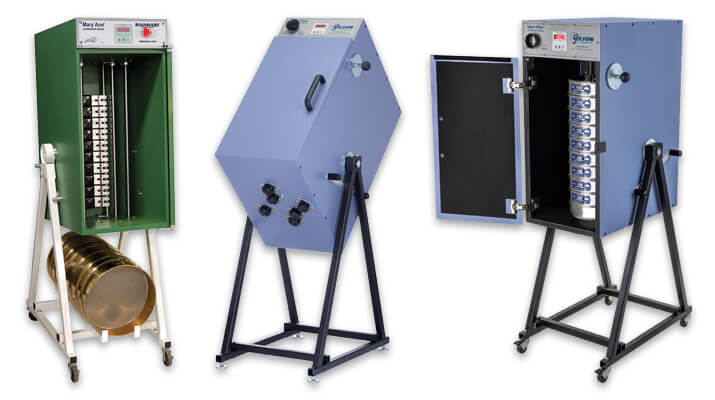
Rotary Sifter Operation
Rotary sifter option is straightforward.
- The stack of round test sieves with a test sample is placed inside the cabinet.
- The door is closed.
- The cabinet is tilted back.
- A set of rollers rotates the stack, and cam-activated tappers rap the sides of the sieves.
- Sample particles are constantly reoriented as they flow across the outer perimeter of the sieve mesh, and the tapping action redistributes the sample across the central area of the mesh, ensuring accurate size fraction separation.
Simple Design for Greater Efficiency
The simple design of rotary sifters lends itself to greater efficiency, which is a valuable commodity in a busy testing lab. The unit accepts 8 or 12in, as well as 200 or 300mm diameter test sieves just by turning a selector knob and adjusting the turntable.
Rotary sifters accept sieve stacks up to 26in (660mm) high for convenience when testing materials that require smaller increments between fractions. For full-height test sieves, the capacity is six 12in dia. or thirteen 8in dia. sieves, including a pan. Using half-height sieves can increase the total capacity to as many as thirteen 12in (305mm) or twenty 8in (203mm) sieves, including catch pans.
Instead of clamping the sieves in place, the sieve stack rests in direct contact with the rubber-coated rollers when the cabinet is tilted back 45° into the testing position, and gravity does the rest. The sieve stack remains secure as it rotates around its axis during the test cycle. Individual hammer assemblies faced with wooden or resilient plastic tappers jar the sides of the sieves to ensure complete fraction separation and accurate results. Handling is minimized, and more time is spent on actual particle separation.
An enclosed cabinet means none of the moving parts are exposed during operation. Much of the dust generated in the sieving process is contained within the enclosure, and the tappers' noise is muffled. Mounting the cabinet on a sturdy steel frame with casters enables easy relocation in the lab.
The Gilson Rotary Sifter: Introduction to a Better Sifter
The original Mary Ann Sifter has served its purpose for many years in many testing labs. Still, our design team at Gilson thought there was room for improvement. The SS-20 was the first model in the Gilson Rotary Sifter series, designed to incorporate our ideas and improvements. This version is similar in appearance to the classic Mary Ann Sifter but with many practical enhancements to materials, design, and performance.
- Strong, dense MDF board is CNC machined for Gilson rotary sifter cabinets. A side-mounted ergonomic handle allows complete control when tilting the cabinet to the test position.
- The cabinet door is mounted on long-lasting, industrial-grade hinges and swings wide for full access to the sifter interior.
- Our Gilson digital countdown controller/timer precisely times testing cycles and saves set times between uses. A one-button pause function suspends and resumes the test cycle with no loss of testing time.
- Long-lasting, heavy-duty tapping hammers are faced with rugged UMHW polyethylene tapping heads.
- An electronic safety switch prevents the operation of the sifter unless the cabinet door is closed.
- A rugged welded steel frame with optional smooth rolling casters allows easy repositioning of the unit anywhere in the lab.
Innovation for Advanced Sifter Models
The development of the first Gilson Rotary Sifter prompted some forward-looking ideas about what an advanced rotary sifter should do. Basic characteristics of the original design presented opportunities to produce advanced models.
Gilson has made noise and dust mitigation in the testing lab a common theme in our design philosophy. The handling, sampling, and testing of dry, granular materials can quickly turn the testing laboratory workspace into a noisy and dusty environment—a place that is not a productive and pleasant place to work. A common sense approach to design and material selection for our Testing Screens, Sieve Shakers, and Sample Splitters and a concern for worker protection has produced options for cleaner, quieter laboratory equipment with no loss in quality or accuracy.
Focusing on Noise
The enclosed cabinet design of the rotary sifter was a primary but unexplored step in the direction of noise and dust suppression. Gilson's cabinet, with its close-fitting machined MDF panels, not only confines the dust generated by test samples, but controls some of the noise propagated by the sieving mechanism.
We added sound-deadening materials and proprietary design features in the construction of our Silent Sifter® and Silent Sifter® ll to control noise propagation. More importantly, we used our expertise in sieving and particle size determinations to ensure these advanced models yield accurate, repeatable test results. Both Gilson Silent Sifter models have noise outputs well below that of standard rotary sifters, yet their accuracy and efficiency remain undiminished.
The Silent Sifter: A Quieter Sifter with No Loss of Performance
Gilson's Silent Sifter has all the advantages of the Gilson Rotary Sifter and features added sound-damping materials and design engineering for reliable worker protection. Measured noise levels are 7–10dB lower than standard rotary sifter models. 4in (101.6mm) locking casters are included for easy mobility in the lab.
The Silent Sifter ll: Minimum Noise, Maximum Performance
The SS-22 Silent Sifter ll takes sound suppression to the next level. Sound-deadening lining is used more extensively, and a heavy-duty over-center latch draws the door tightly against the cabinet for a positive seal. The SS-22 is 8–10dB quieter than the SS-21 model and 16–18dB quieter than any standard rotary sifter.
Additional Resources
Related Gilson Videos
- Gilson Laboratory Rotary Sifters
- Gilson SS-22 Silent Sifter II - The Quietest Rotary Sifter
- Materials Testing and Noise
- Materials Testing and Dust
We hope this article has helped you learn more about the rotary sifter and how Gilson's innovations have maximized its performance.
Gilson Is Here to Help
Contact our testing experts for more information or to discuss your testing application.
Testing Resources
Standard Test Methods, Specifications, and Practices
Individual test methods and specifications referenced in our product descriptions, blog articles, and videos are available for review or purchase from the professional organizations noted.
- ASTM International (American Society for Testing and Materials)
- AASHTO (American Association of State Highway and Transportation Officials)
- ACI (American Concrete Institute)
- State DOTs (Departments of Transportation)
- ISO (International Organization for Standardization)
- BS (British Standards)
- EN (European Standards)


